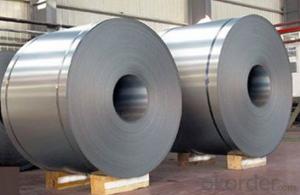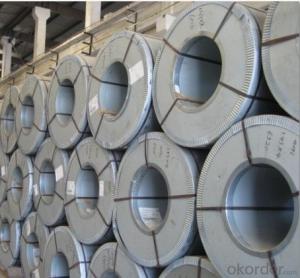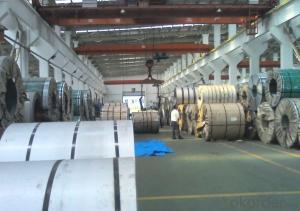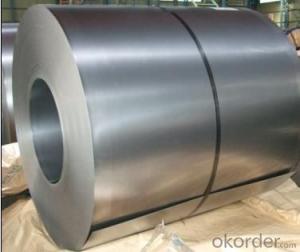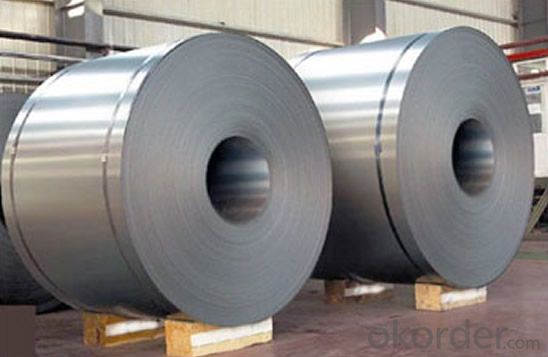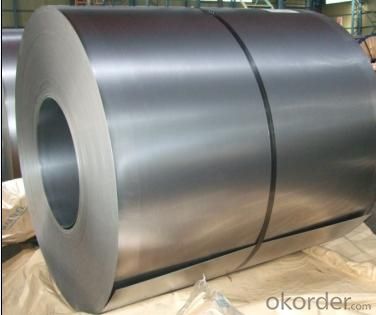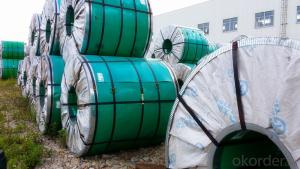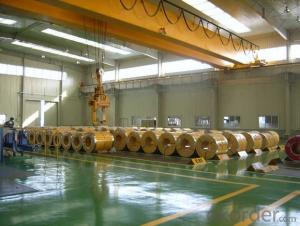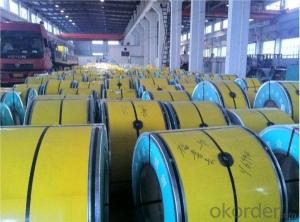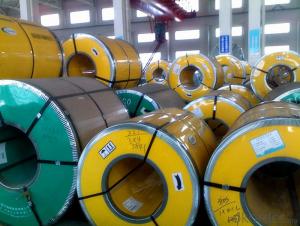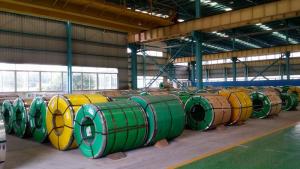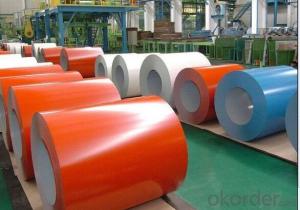Stainless Steel Coil 304 Hot/Cold Rolled 2B/NO.1
- Loading Port:
- Guangzhou
- Payment Terms:
- TT OR LC
- Min Order Qty:
- 100 m.t.
- Supply Capability:
- 20000 m.t./month
OKorder Service Pledge
OKorder Financial Service
You Might Also Like
Hot Rolled Stainless Steel Coil 304 Annealing and Pickling No.1 Finish
Stainless steel is a production which not easy rust,acid resistance and corrosion resistance,so it is widely
used in light industry,heavy industry,daily necessities and the decoration industry.
Hot Rolled Stainless Steel Coil 304 Specifications
1.surface:NO.1
2.standard:JIS, AISI, GB
3.width: 0.55m, 0.65m, 1.0m, 1.22m, 1.5m, 2m or requirement
Hot Rolled Stainless Steel Coil 304 Chemical Composition:
(%):C=0.07, Mn=2.00, P=0.045, S=0.030, Si=0.075, Cr=17.5-19.5, Ni=8.0-10.5, N=0.10
Hot Rolled Stainless Steel Coil 304 Physical Properties
Tensile strength σb (MPa) ≥ 520
the conditions yield strength σ0.2 (MPa) ≥ 205,
elongation δ5 (%) ≥ 40
Reduction of ψ (%) ≥ 50,
hardness: ≤ 187
HB; ≤ 90
HRB; ≤ 200H
- Q: Can stainless steel strips be used in high-pressure applications?
- Yes, stainless steel strips can be used in high-pressure applications. Stainless steel is known for its excellent corrosion resistance and high strength, which makes it suitable for use in various industrial applications, including high-pressure environments. Stainless steel strips are often used in the manufacturing of pressure vessels, pipes, valves, and other components that are exposed to high pressures. The material's ability to withstand elevated pressures, combined with its resistance to corrosion and oxidation, makes stainless steel strips a reliable choice for high-pressure applications. Additionally, stainless steel's heat resistance and durability further contribute to its suitability for use in such demanding conditions.
- Q: How do stainless steel strips perform in coastal environments?
- Coastal environments highly value stainless steel strips because of their exceptional performance. These strips are well-suited to endure the harsh conditions typically found in coastal areas, including high humidity, saltwater exposure, and constant moisture, thanks to their corrosion resistance properties. The presence of chromium in stainless steel results in the formation of a passive layer on the surface. This layer acts as a protective barrier against corrosion, quickly forming when stainless steel is exposed to oxygen. Consequently, the corrosive elements in coastal environments do not affect the underlying metal. Moreover, stainless steel strips possess resistance against pitting and crevice corrosion, which are common problems in coastal regions. Pitting corrosion occurs when small holes or pits appear on the metal surface, while crevice corrosion takes place in confined spaces like gaps or joints. Stainless steel's ability to resist both types of corrosion ensures its long-lasting and durable nature in coastal environments. Aside from its exceptional corrosion resistance, stainless steel is also renowned for its strength and toughness. This quality makes stainless steel strips highly resistant to impact and mechanical stresses present in coastal areas, such as strong winds, waves, and debris. In conclusion, stainless steel strips offer superior performance in coastal environments due to their corrosion resistance, strength, and durability. They are an ideal choice for various applications in coastal regions, including construction, marine equipment, coastal infrastructure, and outdoor furniture, as they provide long-lasting protection against the challenging conditions found in these environments.
- Q: What are the common thickness tolerances for stainless steel strips?
- The common thickness tolerances for stainless steel strips can vary depending on the specific requirements and industry standards. However, typical tolerance ranges for stainless steel strips are generally around +/- 0.005 to 0.010 inches or +/- 0.127 to 0.254 millimeters.
- Q: What are the different grades available in 111 stainless steel strips?
- There are several different grades available in 111 stainless steel strips. The most common grades include 111A, 111B, and 111C. Each grade has its own specific composition and properties that make it suitable for different applications. Grade 111A is a low carbon version of stainless steel, which offers good corrosion resistance and high strength. Grade 111B is a medium carbon stainless steel that provides excellent corrosion resistance and moderate strength. Grade 111C is a high carbon stainless steel, which offers superior strength and hardness, but has slightly lower corrosion resistance compared to the other grades. It is important to consider the specific requirements of your application to determine the most appropriate grade of 111 stainless steel strip to use.
- Q: Can stainless steel strips be used in railway applications?
- Yes, stainless steel strips can be used in railway applications. Stainless steel is known for its corrosion resistance, durability, and strength, which makes it suitable for various railway components such as train doors, window frames, handrails, and interior fittings. Additionally, stainless steel's ability to withstand extreme temperatures and vibrations further contributes to its use in railway applications.
- Q: Are stainless steel strips suitable for low-temperature applications?
- Yes, stainless steel strips are suitable for low-temperature applications. Stainless steel is known for its excellent resistance to corrosion, high strength, and durability, making it an ideal material for use in low-temperature environments. It retains its mechanical properties at extremely low temperatures and remains resistant to cracking, making it reliable for applications such as cryogenic storage, refrigeration, and freezing equipment.
- Q: Are stainless steel strips suitable for heat exchanger tubes?
- Yes, stainless steel strips are suitable for heat exchanger tubes. Stainless steel is known for its excellent corrosion resistance and heat resistance properties, making it an ideal material for heat exchanger applications. Stainless steel strips offer high strength, durability, and resistance to high temperatures, making them suitable for use in heat exchanger tubes. Additionally, stainless steel is easy to clean and maintain, ensuring the long-term performance and reliability of the heat exchanger.
- Q: What are the common width tolerances for stainless steel strips?
- The common width tolerances for stainless steel strips can vary depending on the specific requirements and standards set by the manufacturer or industry. However, some general width tolerances commonly used for stainless steel strips are typically within the range of +/- 0.005 to 0.030 inches. These tolerances ensure that the strips are produced within the specified width range, allowing for consistent and accurate dimensions. It is important to note that the exact tolerance requirements may differ for different applications and industries, so it is advisable to consult the manufacturer or relevant standards to determine the specific tolerances needed for a particular stainless steel strip.
- Q: Are stainless steel strips suitable for food processing?
- Yes, stainless steel strips are suitable for food processing. Stainless steel is highly resistant to corrosion, heat, and chemicals, making it a durable and hygienic material for food processing equipment. It is easy to clean, non-reactive, and does not impart any taste or odor to the food being processed.
- Q: Can stainless steel strips be used in the automotive parts industry?
- Yes, stainless steel strips can be used in the automotive parts industry. Stainless steel is highly durable, corrosion-resistant, and has excellent strength-to-weight ratio, making it suitable for various automotive applications such as exhaust systems, trim, brackets, and reinforcements. Moreover, stainless steel's aesthetic appeal and low maintenance requirements further contribute to its popularity in the automotive industry.
Send your message to us
Stainless Steel Coil 304 Hot/Cold Rolled 2B/NO.1
- Loading Port:
- Guangzhou
- Payment Terms:
- TT OR LC
- Min Order Qty:
- 100 m.t.
- Supply Capability:
- 20000 m.t./month
OKorder Service Pledge
OKorder Financial Service
Similar products
Hot products
Hot Searches
Related keywords
